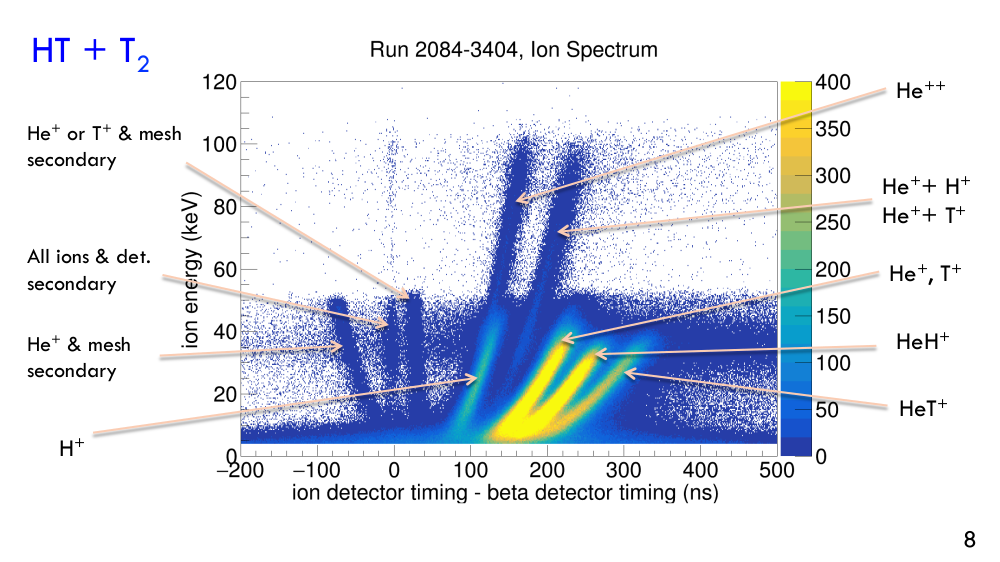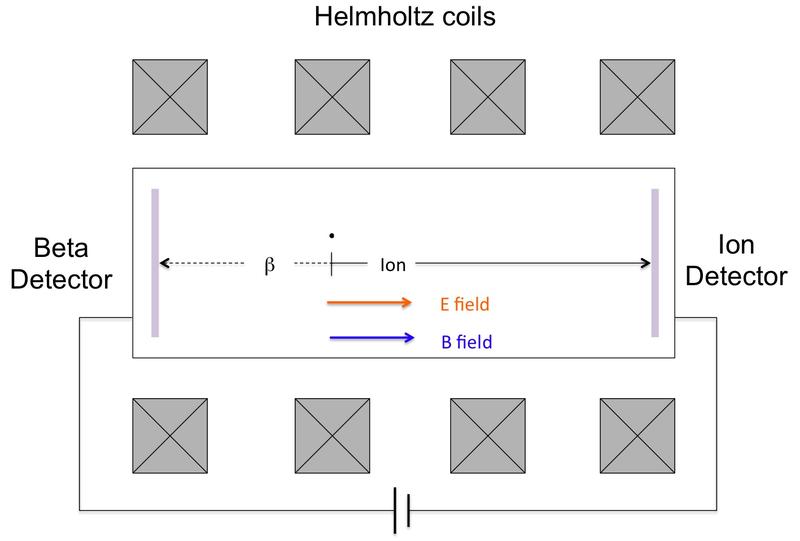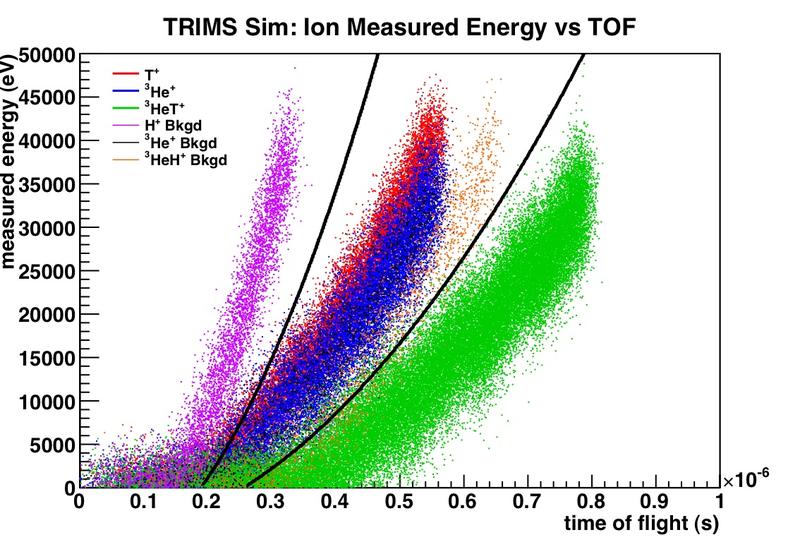Tritium Recoil-Ion Mass Spectrometer
Basic Concept:
The Tritium Recoil-Ion Mass Spectrometer experiment is designed to measure the molecular tritium beta decay branching ratio to the bound molecular ion 3HeT+. The apparatus consists of a time-of-flight mass spectrometer with a silicon detector at each end: one for beta detection and one for ion detection. The spectrometer is filled with high-purity molecular tritium gas at a pressure of ~10-7 mbar. A potential difference of 60 kV is maintained between the two detectors for accelerating the ions and betas above detection threshold. An axial magnetic field guides the charged particles to the detectors. The figure below shows a schematic of the apparatus. The solid line represents the direction of travel of the ion and the dashed line represents the direction of travel of the beta.
Equation 1 shows the relationship between ion energy, the distance the ion travels to the detector (ΔDion), length of the experimental chamber (Lchamber) and voltage drop across the chamber (Vchamber). For accelerating potentials large enough to provide reasonable ion-detection efficiency in silicon (60 kV), the initial energy of the ion is negligible and the ion time of flight is given by Eqn. 2.
We see that the time of flight for mass-3 and mass-6 ions differs by a factor of √2. Thus the measured ion energy and time of flight can be used to determine the mass of the incident ion and extract the branching ratio to the bound molecular ion.
Additionally the ion energy-deposition rate in the silicon detector depends on the nuclear charge. A doubly charged helium nucleus loses more energy in the dead layer (nonactive entrance window) of the detector than a singly charged tritium nucleus of the same kinetic energy. If the energy resolution is high enough and the dead layer thickness optimized, the difference in energy deposition can be used to distinguish between T+ and 3He+. In this setup the dead layer is analogous to dE/dx detectors used in high-energy physics experiments. We are investigating this as a technique to separately measure the branching ratios to T+ and 3He+. Because of the difficulty of this separation, our initial focus has been on the decay of the isotopologue HT, where this problem does not arise.
The decreased sensitivity to initial transverse momentum is a major advantage of the silicon-detector approach. Magnetic guiding increases the overall efficiency and more importantly reduces species dependence. The detection of the coincident primary beta allows for determination of the branching ratio to the bound molecular ion as a function of beta energy, a more detailed test of theoretical calculations.
A full simulation was written to include energy distribution of recoil ions, velocity distribution of recoil ions, energy deposition in silicon (based on SRIM results), energy resolution of detector/electronics and timing resolution of electronics. A sample simulation can be seen below, clearly demonstrating the separation of mass-3 and mass-6 events.
Context:
Molecular tritium beta decay provides the highest laboratory-based sensitivity to the neutrino mass. The Karlsruhe Tritium Neutrino (KATRIN, http://www.katrin.kit.edu/) experiment will push the sensitivity to 0.2 eV, well into the regime where molecular effects impact the measurement. The final-state calculations used in KATRIN analysis have not been tested in modern experiments and implications of the calculations are at odds with dissociation experiments performed in the 1950s. We built the Tritium Recoil-Ion Mass Spectrometer to measure the molecular tritium branching ratio to the bound 3HeT+ ion. This branching ratio is a basic prediction of the theory of the final-state spectrum and provides a test of the validity of calculations used in KATRIN.
The disagreement between theory and experiment has not been satisfactorily explained although many sources of possible experimental error have been proposed, including:
- The acceptance depends on the transverse momentum distribution which differs between the ion species.
- The sudden approximation is only valid near the endpoint while the measurements integrate over the spectrum.
- Contamination of mass-6 signal by ionized T2+ may not have been accounted for properly.
- Repopulation of the ground state would be possible if fast radiative transitions between electronic excited states and the ground state of 3HeT+ exist.
- The parameterization of the bound versus unbound states in the electronic ground state may give rise to errors in the calculation.
- The secondary emission coefficient of the electron multipliers may have been higher for the molecular ions than the atomic ones.
TRIMS will address many of these issues by the use of a time-of-flight spectrometer with semiconductor detectors and magnetic guiding. By measuring the beta energy, the branching ratio as a function of beta energy can be determined. Comparisons will be made with both old experiments and theory.
Data:
TRIMS has been taking data with tritium since early 2018, once a new acceleration column made by NEC had been installed. The new column allowed uneventful operation up to 60 kV and 0.237 T, the full fields. The data look even better than the simulations thanks to improvements in the detector energy and time resolutions.

Collaborators:
University of Washington:
L.I. Bodine, M. Kallander, Y.-T. Lin, E. M. Machado, R. G. H. Robertson
Carnegie-Mellon University:
D. S. Parno, A. P. Vizcaya Hernandez
Karlsruhe Institute of Technology:
W.-J. Baek, C. Claessens, R. Oestertag
References:
Motivation and Review:
L. I. Bodine, D. S. Parno, and R. G. H. Robertson, Assessment of molecular effects on neutrino mass measurements from tritium beta decay. Phys. Rev. C 91, 035505 (2015); https://arxiv.org/abs/1502.03497
Theory:
S. Jonsell, A. Saenz, and P. Froelich, Neutrino-mass determination from tritium beta decay: Corrections to and prospects of experimental verifications of the final-state spectrum, Phys. Rev. C 60, 034601 (1999)
(http://prc.aps.org/forward/PRC/v60/i3/e034601)
N. Doss, J. Tennyson, A. Saenz, and S. Jonsell, Molecular Effects in Investigations of T2 Beta Decay: Influence of Source Temperature and Isotope Distribution, Phys. Rev. C 73, 025502 (2006)
(http://prc.aps.org/pdf/PRC/v73/i2/e025502)
Old experiments:
Arthur H. Snell, Frances Pleasonton, H.E. Leming, Molecular dissociation following radioactive decay: Tritium hydride, Journal of Inorganic and Nuclear Chemistry, Volume 5, Issue 2, 1957, Pages 112-117, ISSN 0022-1902, 10.1016/0022-1902(57)80051-7.
(http://www.sciencedirect.com/science/article/pii/0022190257800517)
S. Wexler, Dissociation of TH and T2 by β-decay, Journal of Inorganic and Nuclear Chemistry, Volume 10, Issues 1–2, April 1959, Pages 8-16, ISSN 0022-1902, 10.1016/0022-1902(59)80180-9.
(http://www.sciencedirect.com/science/article/pii/0022190259801809)




